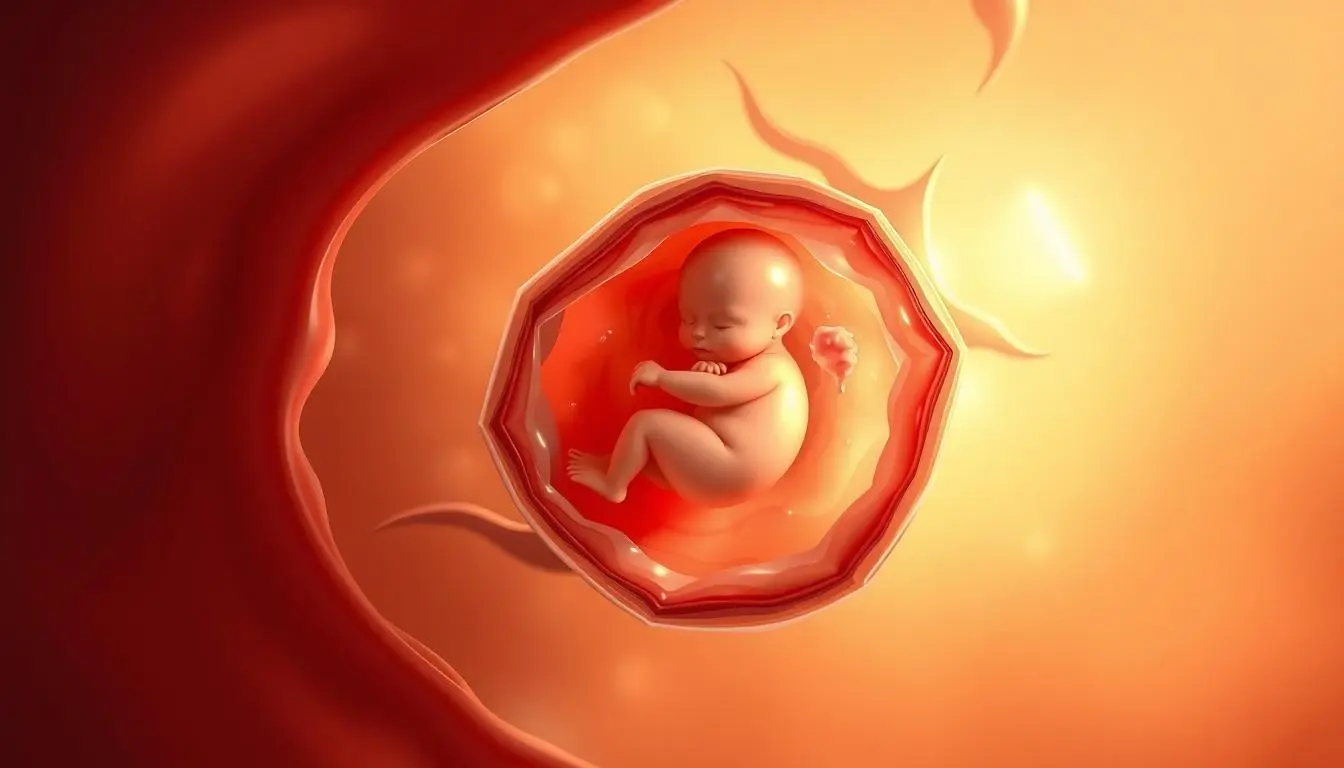When Can Babies Sleep on Their Stomach? It’s vital to know safe sleeping positions for babies for their health. Many parents wonder when infants can start sleeping on their stomach. The American Academy of Pediatrics has rules to lower Sudden Infant Death Syndrome (SIDS) risk.
Dealing with infant sleep can be tough. As a parent, knowing the safest ways is key. This article will share nine important facts about baby sleep positions. It aims to help you make the best choices.
Key Takeaways
- Understanding the risks associated with different sleep positions.
- Guidelines for transitioning your baby to stomach sleeping.
- The importance of following established safe sleep practices.
- Reducing the risk of SIDS through proper sleep positioning.
- Tips for creating a safe sleep environment.
- Monitoring your baby’s development and adjusting sleep practices.
👶 Must-Have Baby Products Every Parent Needs – Shop Top Picks on Amazon
From newborn essentials to toddler favorites, the right baby products can make parenting smoother, safer, and even more joyful. Whether you’re shopping for your own little one or picking the perfect baby shower gift, we’ve got you covered!
🍼 Diapers, wipes, bottles & feeding gear
🛏️ Cribs, bassinets, baby monitors & nursery must-haves
🧴 Lotions, shampoos & sensitive-skin baby care
🎁 Gift sets, toys & accessories
👉 Browse the best baby products on Amazon
✔️ Trusted brands like Pampers, Enfamil, Aveeno Baby, and Graco
✔️ Parent-approved with thousands of 5-star reviews
✔️ Fast delivery & easy returns
Everything you need for baby’s first year — all in one place. 💗
The Importance of Safe Sleep Positions for Infants
Keeping infants safe while they sleep is a top priority. Knowing the safe sleep positions is key. It’s important to make sure infants sleep in a safe way to lower the risk of Sudden Infant Death Syndrome (SIDS) and other dangers.
SIDS Statistics and Risk Factors
SIDS is a big worry for infants, and sleep position is very important in preventing it. The Centers for Disease Control and Prevention (CDC) says SIDS is a leading cause of death in babies from 1 to 12 months. Putting infants on their backs to sleep greatly lowers SIDS risk. It’s vital for parents to know the SIDS risk factors, like being born too early, being underweight, and being exposed to smoke.
The Back to Sleep Campaign and Its Impact
The Back to Sleep campaign started in the 1990s. It aimed to teach parents and caregivers to put infants on their backs to sleep. Led by the American Academy of Pediatrics (AAP) and others, it led to a big drop in SIDS cases. The campaign’s success showed how vital safe sleep practices are and the need for ongoing education and awareness.
Current AAP Guidelines for Infant Sleep Safety
The AAP keeps updating its guidelines for infant sleep safety. They stress the importance of back sleeping, a safe sleep environment, and avoiding bed-sharing. Parents should make sure the sleep area is safe from dangers like soft bedding, toys, and loose blankets. Following these guidelines can greatly lower the risk of SIDS and other sleep problems.
By knowing and using safe sleep practices, parents can make a safer sleep space for their babies. It’s key to keep up with the latest advice and guidelines from trusted sources like the AAP.
When Can Babies Sleep on Their Stomach? The Developmental Timeline
Many parents wonder when it’s safe for babies to sleep on their stomach. As babies grow, their sleep position becomes more important for their safety and comfort.
0-4 Months: Back Sleep Position Only
The American Academy of Pediatrics (AAP) says babies should sleep on their backs until they are 4 months old. This is because back sleeping greatly lowers the risk of Sudden Infant Death Syndrome (SIDS).
Newborns and young babies are not ready to sleep on their stomachs. Their neck muscles are too weak to move their heads if they’re having trouble breathing.
4-12 Months: Managing Rolling Babies
Between 4 to 12 months, babies start rolling over while they sleep. If your baby can roll from their back to their stomach and back again, it’s okay to let them choose their sleep position. But, it’s best to start with them on their back.
Supervision and a safe sleep environment are key during this time. Make sure the crib is clear of soft bedding, toys, and other objects that could be a suffocation risk.

After 12 Months: When Stomach Sleeping Becomes Safer
By 12 months, most babies are strong enough and have good coordination. At this age, the risk of SIDS is lower, and some babies might prefer sleeping on their stomachs.
But, it’s important to keep watching your child’s growth and adjust their sleep area as needed.
Physical Milestones That Indicate Readiness
Some physical signs can show when a baby is ready for stomach sleeping. These include:
- Strong neck muscles
- The ability to roll over in both directions
- Good head control
Watching for these signs can help parents know when their baby is ready for different sleep positions.
5 Critical Facts About Infant Sleep Safety
Safe sleep practices for infants are backed by research. There are five critical facts that every parent should know. These facts ensure their baby’s safety during sleep.
Fact 1: Back Sleeping Reduces SIDS Risk by Over 50%
Placing babies on their backs to sleep significantly reduces Sudden Infant Death Syndrome (SIDS) risk. The American Academy of Pediatrics (AAP) says back sleeping is safest for infants.
Reducing SIDS risk is a top priority for parents. Adopting the back sleep position is a key step.
Fact 2: Sleep Environment Affects Safety More Than You Think
The sleep environment is critical for infant sleep safety. A safe sleep environment includes a firm mattress and tight-fitting sheet. It also excludes soft bedding and toys that could pose suffocation risks.
Ensuring the sleep environment is safe can significantly reduce sleep-related hazards.
Fact 3: Reflux Is Not a Valid Reason for Stomach Sleeping
Some parents think stomach sleeping helps with reflux. But, the risks of stomach sleeping outweigh any benefits. Talking to a pediatrician can help find other ways to manage reflux.
Fact 4: Supervised Sleep Has Different Guidelines
Supervised sleep, like during tummy time, has different rules than unsupervised sleep. Tummy time is key for babies’ development, strengthening neck and back muscles.
It’s important for parents to understand the difference between tummy time and stomach sleeping. This ensures a safe sleep environment and promotes healthy development.
Fact 5: Flat Head Syndrome Can Be Prevented Without Stomach Sleeping
Flat head syndrome, or plagiocephaly, is a concern for parents. But, it can be prevented or minimized. Regularly changing the baby’s sleep position in the crib and providing tummy time helps.
By following these practices, parents can reduce flat head syndrome risk. They don’t need to use stomach sleeping.
4 Practical Considerations for Parents
Parents need to know about safe sleep positions for babies. This is key to keeping your baby safe while they sleep. There are several things you can do to make sure your baby sleeps well.
Tummy Time vs. Stomach Sleeping: Understanding the Difference
Tummy time is when you place your baby on their stomach while they are awake. It helps their neck and back muscles grow strong. It also helps prevent flat head syndrome. But, it’s different from stomach sleeping at night, which is not safe until they reach certain milestones.
Supervised tummy time is good for babies from a few months old, like 2-3 months. It should be on a firm, flat surface. This helps with physical growth and prevents flat head syndrome without risking sleep safety.

What to Do When Your Baby Rolls Over During Sleep
If your baby rolls onto their stomach while sleeping, don’t worry too much. It’s a sign they are getting stronger. But, it’s best to keep them on their back to sleep.
The American Academy of Pediatrics (AAP) says not to panic if your baby rolls onto their stomach. Just gently turn them back over. As they get better at rolling, you can let them choose their sleep position. But always make sure their sleep area is safe.
Creating a Safe Sleep Environment for All Stages
A safe sleep area is very important for babies. Use a firm mattress and keep the crib clear of soft things and toys. Also, make sure the room is at a good temperature.
| Safe Sleep Environment Tips | Description |
|---|---|
| Firm Mattress | Use a firm mattress that fits snugly in the crib. |
| Clear Crib | Keep the crib free of soft bedding, toys, and loose items. |
| Comfortable Room Temperature | Ensure the room is not too hot or cold. |
When to Consult Your Pediatrician About Sleep Positions
It’s a good idea to talk to your pediatrician about your baby’s sleep position. This is true if you have any worries or if your baby has health issues. They can give advice that fits your baby’s needs.
“Always consult with a healthcare professional for personalized advice on infant sleep safety.”
Knowing the difference between tummy time and stomach sleeping is important. Also, knowing how to handle a baby rolling over and creating a safe sleep area are key. And, don’t forget to talk to your pediatrician when you need to. These steps can really help make your baby’s sleep safer.
Conclusion: Balancing Safety and Development in Your Baby’s Sleep Journey
As you guide your baby through their sleep journey, finding a balance is key. Understanding safe sleep practices for infants is vital. It helps lower the risk of SIDS and other dangers.
Knowing your baby’s growth stages is important. It tells you when they can safely sleep on their stomach. The American Academy of Pediatrics suggests sids prevention tips. These include placing your baby on their back and making their sleep area safe.
By mixing safe sleep habits with knowing your baby’s growth, you can help them sleep safely and healthily. Always talk to your pediatrician if you’re worried about your baby’s sleep position or safety.
FAQ
What is the recommended sleep position for infants to reduce the risk of SIDS?
The American Academy of Pediatrics suggests that infants sleep on their backs. This is to lower the risk of Sudden Infant Death Syndrome (SIDS). Back sleeping has been proven to significantly reduce SIDS risk.
At what age can babies start sleeping on their stomach?
Babies can start sleeping on their stomach around 12 months old. At this age, they can roll back onto their backs if needed. Always check with a pediatrician for advice tailored to your baby.
What is tummy time, and how is it different from stomach sleeping?
Tummy time is when a baby is placed on their stomach while awake and watched. It strengthens their neck and back muscles. Stomach sleeping is not recommended until they are developmentally ready, unlike tummy time.
What should I do if my baby rolls onto their stomach while sleeping?
If your baby rolls onto their stomach while sleeping, gently turn them back onto their back. As they get older and more mobile, they might roll back themselves. Always watch their sleep position and adjust as needed.
How can I create a safe sleep environment for my baby?
For a safe sleep environment, make sure the crib has no soft bedding, toys, or loose objects. Use a firm mattress and a tight-fitting sheet. Keep the crib in a room with a comfortable temperature, avoiding overheating or overcooling.
Can I use a sleep positioner or wedge to help my baby sleep on their side or stomach?
No, the American Academy of Pediatrics advises against using sleep positioners or wedges. They can increase the risk of SIDS and suffocation. Stick to the recommended back sleep position and a safe sleep environment.
How can I prevent flat head syndrome without having my baby sleep on their stomach?
To prevent flat head syndrome, provide regular tummy time. Also, vary your baby’s head position when they’re on their back. Try alternating the direction their head faces in the crib and use a firm mattress.
When should I consult my pediatrician about my baby’s sleep position?
Consult your pediatrician if you have concerns about your baby’s sleep position or if they show signs of developmental delays. They can offer personalized guidance and reassurance based on your baby’s unique needs.














